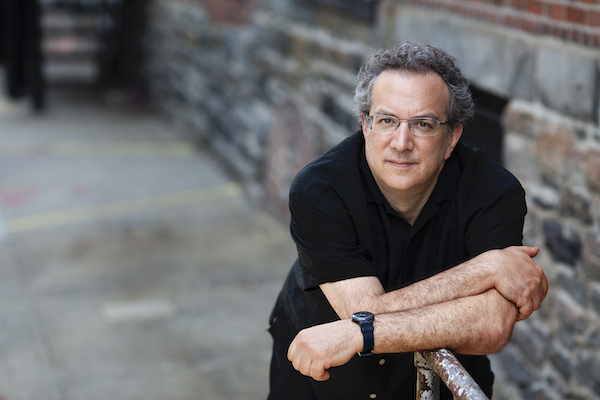Apr 2, 2024 12:59 PM
Saxophonist, Sonic Explorer Casey Benjamin Dies at 45
Casey Benjamin, the alto saxophonist, vocalist, keyboardist and producer who stamped his distinctive sounds on the…

Uri Caine’s most recent album celebrates the work of civil-rights advocate Octavius Catto (1839–’71).
(Photo: Courtesy of Artist)Pianist Uri Caine had no idea that his 10-part oratorio, The Passion Of Octavius Catto, would somehow gain additional cultural relevance in the five years since he first performed it.
The piece, a celebration of Catto—an African American civil-rights pioneer—had its premiere in Philadelphia during 2014. In some ways, that now feels like a different era. President Barack Obama was halfway through his second term, and Donald Trump had yet to announce his bid for the White House. The Charlottesville, Virginia, riots were three years away.
In 2018, Caine decided to record the oratorio, soliciting funds via Kickstarter. The album, which was released in August on the 816 Music label, arrives at a time when there are heated discussions about the nation’s racism—both past and present. The oratorio serves not only as a celebration of one man’s life but also as a reminder of our country’s long, painful history of brutal oppression.
“The very disturbing aspects of the story, the racism that existed … all the indignities and the things that were happening inspired a different kind of music,” Caine, 63, said in a phone interview. The piece, he explained, was more “dissonant” as a result.
Although he is quite historically significant, Catto is not as well known as such 19th-century African-American figures as Booker T. Washington and W.E.B. Du Bois. Born in Charleston, South Carolina, in 1839, Catto grew up primarily in Philadelphia. An advocate of education and equal rights, he helped push Pennsylvania to ratify the 15th Amendment, which extended voting rights to black men. Catto served as principal at the Institute for Colored Youth (now Cheyney University of Pennsylvania), and he was also an accomplished baseball player.
On an election day, Oct. 10, 1871, Catto was shot and killed by an Irish man named Frank Kelly while on his way to vote, as racial tensions in Philadelphia were cresting. In 2017, nearly 150 years after his death, a statue of Catto was erected outside Philadelphia’s City Hall. It was the city’s first public statue honoring an African American.
Caine, who is fluent in jazz and classical idioms, and has performed with the likes of Dave Douglas and Christian McBride, sought to channel Catto’s eventful but truncated life in his 10-part piece, which was commissioned by Philadelphia’s Mann Center. Each musical “chapter,” as Caine put it, zeroes in on a different aspect of history. The rousing “No East No West” incorporates lines from Catto’s speeches at two different voting-rights conventions. The oratorio, which features singer Barbara Walker and two vocal ensembles, packs a punch, incorporating elements of gospel, jazz and classical music.
Even though the composer is a Philadelphia native—whose father, Burton Caine, served as president of the Greater Philadelphia branch of the American Civil Liberties Union—he was not very familiar with Catto’s life prior to this project. His research for the piece centered on the 2010 book Tasting Freedom: Octavius Catto and the Battle for Equality in Civil War America by Daniel R. Biddle and Murray Dubin.
André Raphel, who served as the oratorio’s conductor, said the piece—along with Catto’s message of unity and equality—could not be more urgent today. “All these attempts to divide,” he mused, “that’s not what this country is about. That’s not what it’s about. We should be trying to live together as one.”
On March 19–21, 2020, the Boston Symphony Orchestra—with Caine, Walker and other guests—will perform the piece at Boston Symphony Hall. Caine said he hopes that Catto’s tale will help people see connections between the 19th-century and the current day. “It’s part of history,” he said. “It still explains what we see today.” DB

Benjamin possessed a fluid, round sound on the alto saxophone, and he was often most recognizable by the layers of electronic effects that he put onto the instrument.
Apr 2, 2024 12:59 PM
Casey Benjamin, the alto saxophonist, vocalist, keyboardist and producer who stamped his distinctive sounds on the…

“He’s constructing intelligent musical sentences that connect seamlessly, which is the most important part of linear playing,” Charles McPherson said of alto saxophonist Sonny Red.
Feb 27, 2024 1:40 PM
“I might not have felt this way 30 to 40 years ago, but I’ve reached a point where I can hear value in what people…

Albert “Tootie” Heath (1935–2024) followed in the tradition of drummer Kenny Clarke, his idol.
Apr 5, 2024 10:28 AM
Albert “Tootie” Heath, a drummer of impeccable taste and time who was the youngest of three jazz-legend brothers…

“Both of us are quite grounded in the craft, the tradition and the harmonic sense,” Rosenwinkel said of his experience playing with Allen. “Yet I felt we shared something mystical as well.”
Mar 12, 2024 11:42 AM
“There are a few musicians you hear where, as somebody once said, the molecules in the room change. Geri was one of…

Henry Threadgill performs with Zooid at Big Ears in Knoxville, Tennessee.
Apr 9, 2024 11:30 AM
Big Ears, the annual four-day music celebration that first took place in 2009 in Knoxville, Tennessee, could well be…